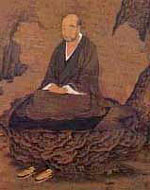Koso Wasan 54
King Hsiao, the Emperor of Liang,
Always faced in the direction
Of our teacher and paid homage to him,
Calling him Bodhisattva Luan.
The Legacy of T'an-luan

It seems to me that the very first thing we need to consider, when we discuss the legacy of a great dharma master like T'an-luan is the very fact of his existence. T'an-luan is an actual person who lived within a specific geographical and historical context. He realised the dharma and, then, passed it on, so that others, through many generations, could share his realisation and gain liberation from birth-and-death (samsara).
The significance of this is that he was a man who embodied the dharma within the framework and physical constraints of his life. So the biographies of the dharma masters are important, since we see in them the dharma being ratified in the life of individuals who needed to struggle with and adopt it within the constraints of a genuinely human existence. The teachings of the sutras are glorious, profoundly illuminating and inspiring but, unless there are people who genuinely realise the teaching in their lives it remains a matter of theory.
T'an-luan was the first to expound an enduring Buddhology.
... all Buddhas and bodhisattvas have dharma-bodies of two dimensions: dharma-body as suchness and dharma-body as compassionate means. Dharma-body as compassionate means arises from dharma-body as suchness, and dharma-body as suchness emerges out of dharma-body as compassionate means. Those two dimensions of dharma-body differ but are not separable; they are one but cannot be regarded as identical.
A little further on in the text we discover the full weight of T'an-luan's Madhyamika theory being brought to bear upon his immortal philosophical underpinning of the Pure Land way:
Because dharma-nature is tranquility, dharma-body is formless. Because it is formless, it never fails to manifest every kind of form. Therefore, the adornment of the Buddha’s features and marks is itself dharma-body.1
Above all, T'an-luan's legacy extends to the fact that he draws to our attenton the idea - already implicit in the Pure Land teaching - that the necessary disposition in Pure Land practice is attained by means of the Other Power.
There are also other more peripheral things we can take from T'an-luan. I also see in him a breadth of vision, a generosity of spirit and an urbanity that is a role model for followers of the dharma. He is, at once, celebrated for the depth of his Madhyamika understanding, his Taoist writings and his Pure Land philosophy. He was a person of path; he followed a course that led to his final refuge in the nembutsu. At the same time his writings convey the sense of an individual of such warmth and humanity that he is the kind of person you could comfortably visit for a quiet chat and a cup of tea.
Although his fragile health seems to have been a life-long burden, he was renowned for his kindness and compassion. This indicates that he had realised shunya ta - the voidness of all dharmas. He was completely devoid of prejudice, welcoming to his cliff-side hermitage both rich and poor, powerful and weak. His compassion, arising as it does from his attainment of the perfection of wisdom, his faith, is profound - and profoundly moving. The first time I read his account of the causes that inspired Amida Buddha to create his Pure Land for the sake of suffering beings, I was so moved by the depth of his compassion and pathos that I was reduced to tears.
T'an-luan's compassion is so selfless, powerful and radiant that I do not think I have encountered anything like it anywhere else - except perhaps in Shan-tao or Shantideva. It is a compassion which found both a conduit and a recipient in Shinran Shonin. It is so striking that one can almost feel it as a living, guiding presence. I feel certain that T'an-luan was, without question, completely at one with Amida Buddha; and, as he comes to mind now, the two seem indistinguishable.
1: CWS. p. 165.